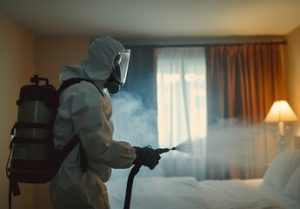Ben’s Pest Control focuses on keeping unwanted insects, weeds, nematodes, or vertebrate animals from damaging crops and property. Understanding the conditions that encouraged infestations helps you select the most appropriate management options.

Physical methods remove, block, or trap pests using direct action. Examples include neem oil, which interferes with insect feeding and reproduction, and diatomaceous earth, which scratches or dehydrates soft-bodied pests like ants.
There are a number of preventive measures you can take to keep pests out of your home or business. These include:
Cleaning: Keeping living spaces clean reduces their attractiveness to pests. Rodents, cockroaches, and other pests thrive in messy environments where crumbs, spills, and food debris are readily available. Routinely wiping down kitchen counters, storing food in sealed containers, and vacuuming frequently, particularly dark corners and other hidden areas where pests like to hide, are critical to preventing infestations.
Garbage disposal: Regularly discarding trash, and ensuring garbage cans are properly sealed, is another important preventive measure. Ensure that your yard is free of weeds and overgrown vegetation that may serve as hiding spots for rodents or other pests.
Eliminating Standing Water: Pests such as flies, roaches, and mosquitoes love moist environments where they can breed. Eliminating sources of standing water on your property, including puddles and ponds, is essential to helping prevent these pests from making their way indoors.
Sealing Potential Entry Points: Since many pests can fit through holes and cracks that are the size of a dime, it is a good idea to conduct a thorough assessment of your property to identify and seal these gaps. Installing weather stripping around doors and windows, repairing leaky pipes, and fixing cracks in walls, foundations, and around utility entries are a few simple steps that can significantly improve your property’s protection against pest invasions.
Spring
Whether it’s rodents seeking warmth and shelter or cockroaches thriving in damp conditions, pest populations rise as temperatures warm up. A mild winter usually means a busy spring for pest control as pests emerge from their hiding spots to search for food, water, and nesting sites.
Warmer weather speeds up pests’ metabolisms, increasing movement and reproduction rates. In addition, heavy rainfall creates ideal conditions for insects, as puddles and standing water serve as breeding grounds. This can cause a surge in pests like termites, ants, mosquitoes, and roaches.
Seasonal migration also plays a role. When the temperature drops, rodents like rats and mice seek warmth and shelter indoors, leading them to invade homes. Rodents are more likely to enter through unscreened vents and open doors, but they may also infiltrate through ductwork and crawl spaces. Rodents may also infest attics and walls, where they can lay their eggs.
As the weather warms, cockroaches also become more active, but their movements are typically less obvious. Cockroaches are drawn to moisture and can find it around your home in a variety of ways, including in kitchen drains and clogged gutters.
A hygienic environment and proper food storage can prevent many of these pests from entering your home. Cleaning and sanitizing the outside of your home will help, as will sealing up entry points.
In addition, it’s important to have your property regularly inspected for potential signs of pests. A professional can catch pests before they have a chance to breed and spread, making it much easier to keep them away. A ten-percent reduction in pests in the spring can result in hundreds or thousands of fewer pests later on.
Summer
With the summer comes hot, humid weather that brings increased pest activity and visibility. In addition to the heightened presence of mosquitoes, cockroaches, termites and ants, you can expect stinging insects like hornets and yellow jackets, as well as rodents such as mice, rats and squirrels to be more active in and around your home.
The reason is that these pests are triggered by the warm temperatures to reproduce and seek food, shelter and water sources. Aside from this, they also have a strong survival instinct and will aggressively seek out new areas to live and eat during the hot summer months.
Aside from the annoyance of these pests, they pose health concerns and can be quite damaging to your property. Mosquitoes are notorious for spreading diseases such as Zika and West Nile virus, while flies, ants, cockroaches and ticks can contaminate food and surfaces with harmful bacteria.
It’s important to keep your property well-maintained during the summer to minimize these pests. For example, eliminate standing water by removing containers and toys from the yard, making sure your gutters are free-flowing and addressing leaky pipes. Keep garbage bins tightly sealed and empty, and clean up food residue and debris regularly.
Additionally, trim bushes and trees to prevent these pests from using them as ladders into your home or to make nests in the foliage. Lastly, seal entry points by caulking cracks around windows and doors. By taking these precautions, you can enjoy the summer without dealing with pesky pests ruining your fun!
Fall
As summer begins to wind down and the weather turns colder, pests begin moving indoors. Rodents, spiders, termites, and other pests look for cozy nesting places to survive the winter. These pests can get into homes through doors and windows, especially if they’re left open. It’s important to keep these areas screened and properly sealed this time of year.
If unseasonably warm temperatures persist into the fall, tick and mosquito populations will remain high until drier conditions arrive. This, in turn, could cause rodent problems to increase as they move indoors to seek shelter and food sources.
The onset of cooler weather also drives overwintering pests, such as brown marmorated stink bugs and Asian lady beetles, into homes. These pests seek shelter from the cold in wall voids and other hidden areas where they can stay dormant until spring.
Rodents, like mice and rats, also move indoors as the weather cools, seeking shelter and food sources. These rodents can damage the insides of homes and buildings, and may contaminate food in pantries and kitchen cabinets.
If you have a lot of firewood, it’s best to store it far away from your home and keep it covered with a tarp to prevent termites and other pests from invading your property. Also, keeping your yard clean and free of weeds, debris, and other clutter can help to deter pests from entering your home. Lastly, getting your home sprayed in the fall can help deter pests into the winter and protect you and your family from pest-borne diseases.
Winter
Many homeowners breathe a sigh of relief when winter hits and believe their pest control is no longer necessary. But the reality is, pests don’t take a break for the winter. Pests like cockroaches, fleas, bed bugs, and rodents are experts at adapting to cold weather and finding ways to thrive inside homes and apartments.
Pests can’t hibernate or freeze like some mammals, so they look for shelter and food as temperatures drop. This is why a year-round pest control program is so important.
While some pests may disappear for the winter, others such as mosquitoes and flies will not. In order to survive the winter, these insects will enter a state of diapause and store fat, then find sheltered places such as storm drains where they can wait until warmer weather arrives.
Rodents, cockroaches, and spiders also seek warmth and shelter during the winter months. These pests can fit into tight spaces and find cracks in walls and floors to nestle, where they can breed until warmer weather arrives.
With a regular treatment plan, you can keep pest populations low, and prevent infestations from escalating in the spring. Taking care of pests during the winter can save you money, stress, and time in the long run.
During the winter, pests are more centralized and easier to target, making them more susceptible to treatments. Taking measures such as sealing all open gaps around your home, installing door sweeps and screens, and keeping crawl spaces, basements and attics well ventilated will help to keep pests out of your home. Regular pest treatments during the winter can also break up their reproductive cycles, reducing the number of unwanted pests that invade in the spring.


